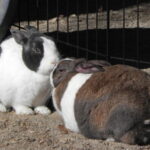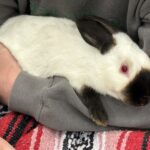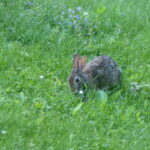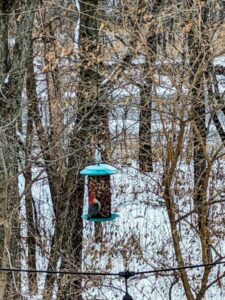by Marion Patterson | Aug 29, 2024 | (Sub)Urban Homesteading, Foraging
Eatin’ Weeds
We don’t just pull weeds. We eat them!
Every summer gardeners spend hours pulling, digging, and spraying weeds that pop up overnight and grow like – Weeds! Marion’s family, especially grew up eatin’ weeds. Raised on a small, hardscrabble New Hampshire farm where the biggest crop was rocks, her family of seven supplemented produce with wild foods. Her dad, of the Depression era, knew the wild plants. So, she grew up eatin’ weeds and picking wild berries.
At the nature center in Kansas Rich was always looking for unique programs to present and wild edibles were a hit. Using the Euell Gibbons and Adrienne Crowhurst wild food guides, we learned which foods have the highest returns: easy to gather and process, moderately difficult yet rewarding, and survival-only foods.
We also realized that many are as tasty and nutritious as intentionally planted crops.
Dozens of weed species are edible, but we especially enjoy eating lambs quarter, purslane, and Asian dayflower that we haven’t planted but harvest from our garden. All were introduced from faraway continents and have gone wild. Each is easy to identify.
Lambs quarter

Lamb’s Quarters readily grow in disturbed soil.
This Eurasian native plant has many names. It’s sometimes called lamb’s quarters, goosefoot, or pigweed and has the scientific name Chenopodium album. Lambs quarter is a fast-growing annual weed that we first notice in early spring. We pick and eat it about the same time in April that we plant spinach and lettuce. We keep picking and eating the new shoots as the season advances.
Identification and Preparing
Lambs quarter is easy to identify. One characteristic we like is the leaf’s ability to shed water. Dunk a leaf in water and it looks silvery. Like most wild and garden greens, Lambs quarter is best when picked young and tender. We wash and steam it for a few minutes, much like we cook Swiss chard. Topped with melted butter, it’s delicious. Very young leaves can be rinsed and eaten raw in salad.
Asiatic Dayflower

Likes partial shade.
Since lambs quarter is wind pollinated its flowers aren’t showy. That’s not the case with Asiatic dayflower. Its sky-blue blooms last only a single day but add color to our garden. It prefers living in partial shade and thrives under our rain barrels and alongside raised beds in the garden. Botanists call it Commelina communis.
Like lambs quarter, the young leaves and stems are delicious in a salad or can be lightly steamed.
Purslane

Cultivated world wide
Although Americans constantly pull weedy purslane from their gardens, it is actually a planted crop in India and the US Southwest. Native to the Mediterranean region, it was introduced around the world centuries ago. Purslane is a fleshy plant with the scientific name of Portulaca oleracea.
Purslane grows like crazy and loves hot soil and full sun. It’s somewhat mucilaginous and tends to be gritty. Well-washed young stems and leaves can be eaten raw or steamed. The plant is high in oxalates, so people with kidney problems may want to avoid eating it.
Foraging and Safety
In this era of high food prices families seek ways to trim the grocery bill. Gardening helps and a small flock of backyard chickens adds delicious eggs, but foraging wild foods is becoming increasingly popular.
There are cautions. Many plants have lookalikes that could be inedible or even toxic.
Fortunately, the Internet is loaded with reliable information that helps a novice identify edible plants and learn how to harvest and prepare them for the table. Plenty of printed books are available, but the very best way to learn is to find a skilled forager and tag along on a collecting spree.
Cardinal Rule and Cautions
A cardinal foraging rule is to identify any new plant by at least three sources before attempting to eat it. Don’t take our word for it. If you want to try the plants we mention above, double check identification and edibility on at least two websites, books, or with an expert person.
Cautions. Most people may be able to enjoy eating a certain plant but you may be allergic to it. So, for the first meal or two eat a new food sparingly to make sure no unpleasant symptoms arise. Also, avoid picking plants that may have been sprayed or are alongside a road or near a factory where they might be contaminated by emissions. If you want to go on private property, always have landowner permission before collecting. In public parks make sure picking or gathering is permitted before picking.
Resources
Books:
Euell Gibbon’s classic Stalking the Wild Asparagus got us started on foraging decades ago.
A comprehensive modern book is Nicole Apelian’s Foragers Guide to Wild Foods.
Adrienne Crowhurst’s classics, The Weed Cookbook and The Flower Cookbook were staples in Marion’s family.
App: An app that helps identify edible and nonedible plants is SEEK by iNaturalist.
Websites: There are many. Often a good way to use a website is to first identify a plant and then GOOGLE it. Usually, that will lead to sites that further help identify the plant, give its history, and tell whether it is edible or toxic.
by Marion Patterson | Aug 1, 2024 | Garden/Yard, Mammals, Pests

Young rabbits “play” to gain skills and show dominance.
Have you noticed the abundance of the cottontail rabbit this summer? While they can create mischief as in eating desired plants, they also are fun to watch.
Winding Pathway’s resident cottontail rabbits give us delightful evening entertainment. Shortly after sunset, a few appear like magic from out of our labyrinth’s tall prairie. As we sit on our porch they scamper about, chase each other, and nibble on the white clover poking out of our lawn.
Many people dislike cottontails for their habit of feasting on favored garden plants and gnawing on tree bark in the winter. Because we enjoy both rabbits and Swiss Chard, we keep them away from our vegetables and, thus, appreciate their antics.
Several cottontail species range across most of the United States, southern Canada, and South America. They’re well adapted to thrive in diverse environments. Ours is the Eastern Cottontail rabbit. This year they are especially abundant.
There are Rabbits and Then There are Rabbits

Side by side
Cottontails and common domestic pet rabbits may look similar but they are vastly different.
Pet Bunnies
Pet bunnies trace their ancestry to Europe and were domesticated thousands of years ago. They make fascinating and loveable pets and thrive in a safe roomy hutch eating commercial pellets. These are the rabbits that were released in Australia and caused enormous agricultural and ecological damage. They readily breed, are social, and join others to dig a series of burrows called warrens. Some readers may remember the award-winning novel, Watership Down, and the Netflix series about precocious rabbits.
-

-
Children and adults enjoy bunnies.
-

-
Rabbits are social.
-

-
Friendly pets
-

-
European rabbits adapt to people
-

-
Show animals.
-

-
Children with rabbits
Cottontail Rabbits
Cottontails, in contrast, are wild animals that rarely, if ever, become tame or make good pets. Like European rabbits they are social and like the company of other bunnies but not people. Cottontails don’t make burrows but sometimes enjoy ducking down an abandoned woodchuck hole. Cottontails live under dense vegetation, in culverts, and under outbuildings. They eat a wide range of wild plants but love snacking on vegetables. In winter they sometimes eat the bark off young trees. So, be sure to protect your young trees with wire mesh around the base.
-

-
Time for an evening snack.
-

-
bunny play
-

-
Nibbling clover
Enjoying Both Cottontails and Vegetables
Years ago, we learned a trick that lets us enjoy our resident cottontails and abundance from the garden. European rabbits are high jumpers, but not cottontails. Instead, native bunnies are long jumpers who can’t jump high. Just a wimpy two-foot-tall chicken wire fence around the garden or a young tree keeps them away as long as they can’t get under it.
-

-
Keep rabbits away from young trees.
-

-
Cottontails cannot jump high.
Why So Many Cottontails This Year
For the past few years, Iowa has been in drought. It limited the new tender growth of clovers and other delectable plants that bunnies love. Sparse rain thinned thickets where they hide. This year’s been wet. Vegetation is tender and abundant yet we’ve not had big early thunderstorms. Why’s that important to a cottontail?
Before giving birth, a cottontail digs a shallow hole in the ground, often near the edge of a lawn. She lines it with fur and soon deposits three to eight tiny blind helpless babies. Mom mostly stays away but nurses them in the morning or evening by sitting over the burrow and letting her babies nurse. They grow amazingly fast and are out on their own when only about three weeks old. Mom soon gets ready for another litter.
Who Doesn’t Love a Cottontail Rabbit?
Predators love rabbits. They’re a favorite meal for dogs, cats, raptors, snakes, foxes, and coyotes. There are always rabbits because their survival strategy is to have many babies, even though only a small percent reach adulthood and reproduce.
Getting Rid of Cottontails
Well, why do it? They are inquisitive and beautiful animals that share yards with people.
An easy solution is to run chicken wire around desirable plants to keep them away. So, people can have their plants and rabbits, too.
Hooray for bunnies! They brighten our evenings as they scamper about our yard.
-

-
Rabbits know to stay hidden
-

-
Cottontails live in the labyrinth.
-

-
Nibbling clover
by Marion Patterson | Jul 18, 2024 | Garden/Yard
This blog was first published in the Cedar Rapids Gazette, on June 30, 2024
As Dad and Mom entered their 90s they increasingly struggled maintaining the safety and cleanliness of the home they’d lived in for 60 years. Despite our urging they resisted moving to a senior residence. Although emotionally and physically draining we eventually had to move them to a senior residence. Mom died a year later and Dad enjoyed six pleasant years until his death last year.

This yard offers little to wildlife.
Dad quickly made friends at the facility. The food was excellent, and the staff and fellow residents were helpful and caring. Although it met his basic needs Dad often expressed frustration that the senior residence lacked things he valued. The grounds were immaculately tended. Nary a blade of grass was out of place. It was a wildlife and native plant desert that frustrated a man who loved animals and natural diversity. Sidewalks bordered the manicured lawns but none traversed natural vegetation. Recycling was minimal and abundant waste was dumpstered. As a career teacher, Dad loved interacting with children. They were absent at his new home.
We turn 75 this year. As much as we love our home and yard we recognize that calendar pages advance and someday we may need to live where life is easier and, hopefully, pleasant. So, we’re researching.
Sterile Environments Lack Interest
Flyers advertising Corridor senior residences come to our mailbox, television, and computer. We’ve driven by some and toured a few. All seem well managed and fill basic needs, but few address important values Dad found lacking at his last home. And that we value.
The grounds of most senior residences are manicured and manipulated. Pristine. Even occasional ponds are lined with white rocks that communicate sterility. Where are the cattails? We crave grounds alive with wildlife and native plants, all accessible by rails winding past thickets and ponds.
Seeing photos of older people playing cornhole at their senior residence communicates boredom to us. Like Dad, we don’t just desire, but require, access to natural beauty. We know interacting with nature adds enjoyment and meaning to life…..as does recycling, composting, and gardening. We’ve yet to find a place in the Corridor that offers us a lifestyle we find attractive.
Catching Our Eye
An ad in SMITHSONIAN Magazine caught our eye. It featured lifestyles offered by facilities managed by the nonprofit Kendal, including one in Oberlin, Ohio. A June trip brought us nearby, so we stopped in.
As we entered the grounds and drove to their office we felt “at home.” Clover lawns proved they shun herbicides. Eight ponds sustained lilies and cattails as birds zoomed in front of our car, and trails penetrated natural areas. It was like a senior residence set in a nature center.
Kendal at Oberlin, Ohio
Marketing Manager, Terry Kovach, confirmed that Kendal prioritizes recycling, composting, energy efficiency, and children. “Our in-house daycare and preschool help us recruit staff who have young children. And, these amenities also enable older residents to interact with kids. It helps everyone,” said Kovach. “Residents swim with their grand friends and help them learn to cook through the cooking club. Volunteering to help kids would have brought joy to Mom and Dad but was impossible where they lived.
Additionally, wide trails lead to the cozy town of Oberlin, Ohio, with quaint stores, eateries, and coffee shops. Oberlin College and Conservatory is well-known for music and diverse studies. Residents at Kendal take in their programs. The College is also taking strides to convert to geothermal and reduce its carbon footprint. We toured town, enjoyed a coffee shop and browsed some stores before leaving.
After only an hour at Kendal, we felt comfortable. The nonprofit company has similar senior residences in several eastern states and is building two in California. Perhaps they’ll come to Iowa. Or, maybe there is a similar existing senior residence in the Corridor we’ve yet to discover.
Lots to Consider
We’re not yet ready to send a deposit to any senior residence, but when we do it will be a place where we feel at home in a place that shares our values.
by Marion Patterson | Mar 7, 2024 | Reflections/Profiles, Wonderment
Dupuytren’s Contracture: The Curse of the Vikings! Usually, we blog about nature and yards at Winding Pathways, but once in a while, we digress. This one’s about Rich’s Dupuytren’s adventure. But it is related to nature, as putting on gloves and manipulating his hand was becoming more difficult as two of his fingers began to curl. Also, genetics is nature.
Dupuytren’s Contracture is fairly common. It runs in families. The fingers on Rich’s Dad, Henry Patterson, curled so severely that manipulating tools, knobs, buttons, and eating utensils became difficult despite two surgeries to correct the condition.
Curse of the Vikings
So, what is it? Dupuytren’s Contracture was named for a French surgeon who described it first. It’s most common in men with Northern European ancestry, especially from Scandinavia and Scotland. That fits. Rich’s ancestors were from Denmark and Germany.

It’s caused when a knot of fascia forms under the skin usually in the palms beneath the ring finger and pinky. Sometimes a hard cord of material grows up the finger, forcing it to curl downward. Eventually, the finger can curl to about 90 degrees from the palm.
Women can get the condition, but less frequently than men, and often it’s not as severe.
Watchful
Rich first noticed a knot in his palm when he was 55 years old and gradually two of his fingers began to curl, making it impossible for them to lay flat on a table. There’s no way to predict whether Dupuytren’s will continue to grow or ever become a problem.
For many years Rich’s hand functioned normally with a slightly curved ring finger.
Doing Something About This
About two years ago he visited Dr. Clifford Novak, a hand surgeon at Cedar Rapids’ Physicians Clinic of Iowa. He encouraged Rich to return if the condition worsened or interfered with everyday activities. It started to, so in mid-2023 he again visited Dr. Novak and learned of three possible treatments: surgery to remove the material, needle aponeurotomy to cut the long cord causing the curl, and chemical treatment.
Because his condition was not profound and recovery sounded the easiest, he chose the needle method.
Surgery

The hand was bandaged for four days.
On February 23, 2023, Dr. Novak performed the surgery. Rich stayed in the outpatient Surgery Center for just four hours. He left with his hand heavily bandaged, making typing and any other form of manipulation difficult….but for only four days. On February 27th a physical therapist removed the bandages and gave Rich a series of exercises to help straighten the finger. Amazingly there were no sores or scars where the needles were inserted. For the first time in several years, he could lay all his fingers flat on a table. There was no pain. The result is amazing.
Follow-Up
There’s no assurance the Dupuytren won’t grow back in the same finger or progress in other fingers, but the surgery was so successful it could be repeated if needed.
Dr. Novak’s advice was to treat the curled finger BEFORE it became difficult to use.
Rich did this with success as these after photos reveal.
-

-
Improved straightened finger.
-

-
Exercises are simple and critical to recovering use of the finger.
by Marion Patterson | Dec 21, 2023 | Nature, Pests
House Sparrow Blues
One of our favorite Thanksgiving Day activities is enjoying a sumptuous meal while watching chickadees, nuthatches, cardinals, and woodpeckers enjoy the seeds we put out for them just outside our window.
Thanksgiving 2023 brought mostly frustration. Crowds of House Sparrows swarmed our feeders with hardly a native bird in sight. Formerly known as English Sparrows, there seem to be more of these pesky immigrants every year.
Strategies
We’re not alone. A common phone call or email that comes to Winding Pathways seeks ways to feed native birds and discourage hordes of House Sparrows. Over the years we’ve tried these things to discourage the hardy and prolific Eurasian birds:
- Putting only small amounts of feed out in the early morning and late afternoon when native birds visit and House Sparrows are mostly gone.
- Cutting silo feeder perches short to make it harder for the somewhat clumsy sparrows to perch and eat.
- Sprinkle some whole corn on the lawn. It’s too big for sparrows to eat but blue jays and woodpeckers devour it.
- Sprinkle cracked corn way out in the backyard to entice sparrows away from our main feeders.
- Eliminate sparrow nesting sites around our yard and pull out any nests that form under eaves or in tight spaces along the house.
Result
None of these has worked particularly well.
Others More Fortunate
While we are frustrated, other people are fortunate. We recently enjoyed watching a procession of native birds visiting Jody Vrieze’s feeders in a rural area near Charles City, Iowa. It’s along the Cedar River and away from town. Perhaps her home and yard are a key to avoiding sparrow numbers.
-

-
Jays swallow large nuts.
-

-
Cardinals enjoy eating on the ground.
-

-
Woods attract native birds.
-

-
Many woodpeckers come to the feeders.
-

-
Open water is important for wildlife.
-

-
Peanut butter log.
What is a Synanthrope? How Do They Spread?
They are true synanthropes, meaning they need to live close to people. Backpack into a wilderness anywhere and House Sparrows are one bird that won’t be spotted. Jody’s home is in a wooded area away from town, which is probably why the pesky birds don’t visit her feeders often.
Although not liked by most birders, House Sparrows are amazing. A few were captured in Europe and released in Brooklyn, NY, in 1851. Within 50 years they had spread across the continent and are found in and near almost every town and farm. They may have peaked in numbers late in the 1800s when abundant urban horse manure provided plenty of food.
Although native to Europe and Asia, House Sparrows have spread, due to people importing them, to North and South America, Australia, New Zealand, and parts of Africa. A surefire place to not see them is Antarctica.
-

-
Eating from platform feeder
-

-
Thick beak of house sparrow is good for cracking corn.
Winding Pathways Asks for Help
Most people share their suburban and urban homes with plenty of House Sparrows, and moving to a wild area isn’t an option. So, what to do? Well, we listed what we do yet still have plenty of sparrows, so we’re asking for help from visitors to our Winding Pathways website. Please let us know if you’ve found a consistent and effective way to discourage this pesky bird.
Learn More
For much more information on this amazingly prolific bird go to allaboutbirds.org.
Photos by Jody Vrieze.































